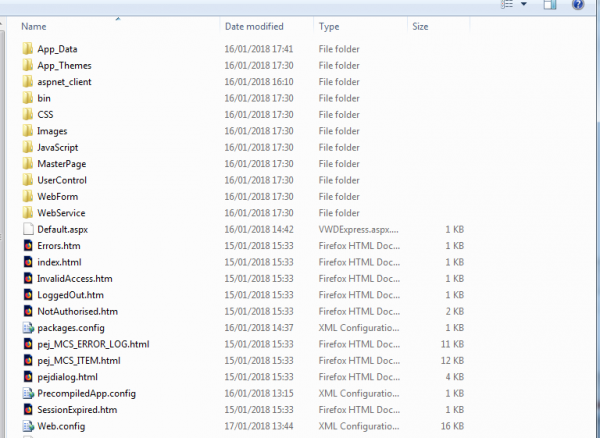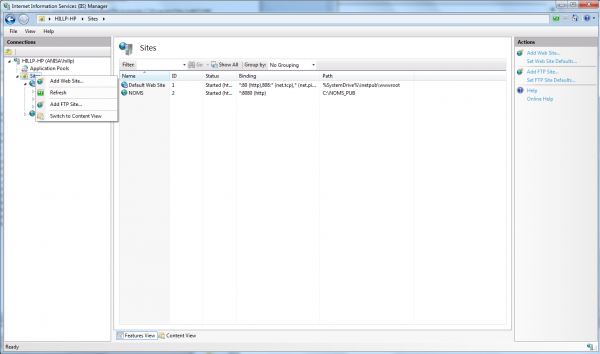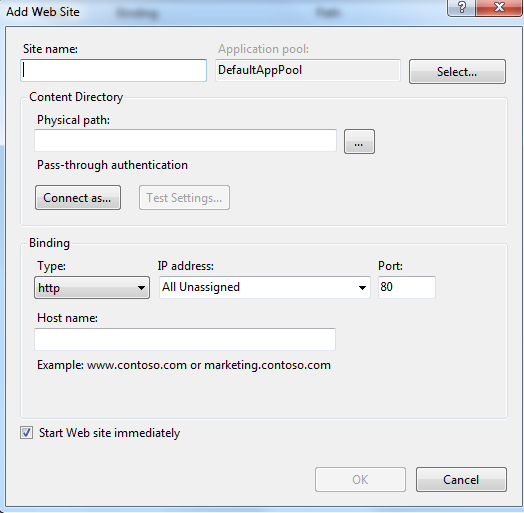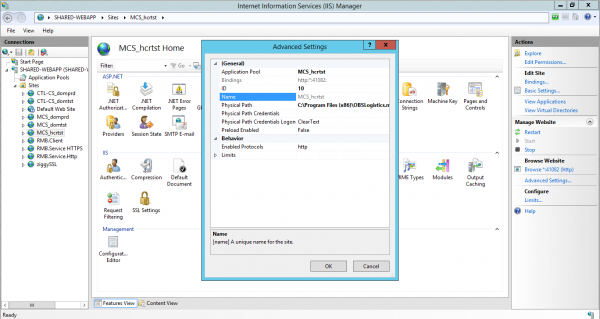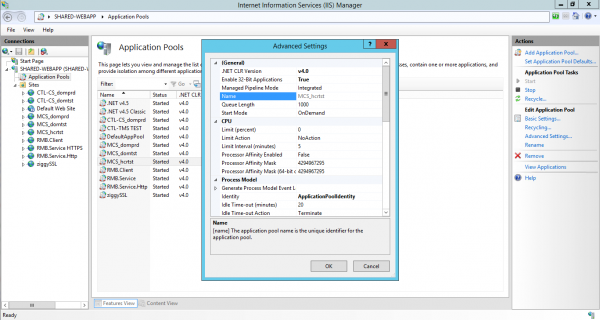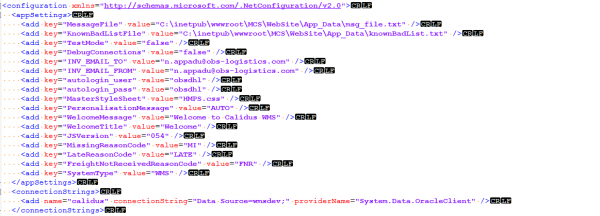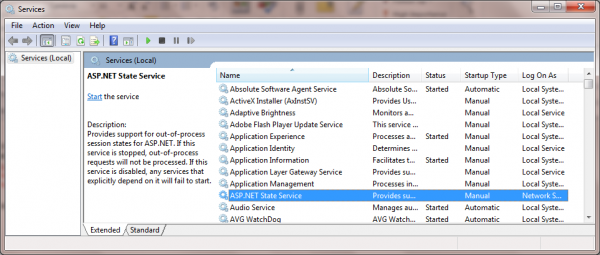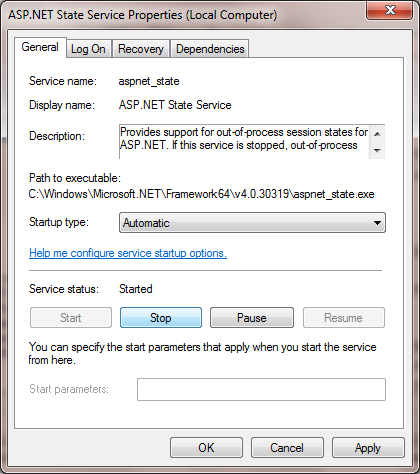OV 320722 CALIDUS MCS Installation Guide
![]()
Aptean
C-MCS Installation Guide
CALIDUS MCS
20th November 2019 - 1.0
Reference: FS UG 320722
Contents
Server Installation
Info
Latest builds can be found in the following directory on the projects drive
P:\Development\MCS\Release Logs\Release
The release notes and change log can be found at the following location, it will be the developers responsibility to fill in these documents
P:\Development\MCS\Release Logs
LFS is currently the only client which uses MCS the QA box can be accessed from IP 172.151.45.173
Dependencies
- .NET Framework 4.7 Runtime
- Oracle Client 11.0.2 or 11.0.3
- Oracle ODT with ODAC 11.2.0.3
General Release Process
Copy the latest build zip file to server(I usually do to the desktop for convenience, then delete when I’m finished)
Extract zip file to a new directory somewhere on the box( for example C:\Program Files (x86)\OBS Logistics\MCS)
Contents of directory should looks as follows
Open the "inetmgr" program
Right click sites, then "Add Web Site.."
Enter the site information in the following popup,
- Site name – internal reference(product name and client e.g. "MCS_NOMS")
- Physical path should be the directory the MCS source files where extracted to
- The "connect as" button is used for configuring security settings, this should be left at the default "pass-through authentication"
- The port will need to be unique for the box
- I believe https certificates are usually applied using a reverse-proxy apache server, so leave the type on "http"
By default, creation of a new site in IIS will create a new Application Pool of the same name. This must be capable of running 32bit apps. To achieve this:
Note the Application Pool created, or find by clicking the site in the Connections explorer, and clicking Advanced Settings in the action pane.
Click Application Pools in the Connections explorer, click the application pool and click Advanced Settings in the Actions pane. Double-click Enable 32-Bit Applications to set the value to True and click OK.
The app configuration is done through the web config file, the "MessageFile" and "knownBadListFile" will need their location updating, while the email addresses and the "connectionString" will need updating for the specific client.
Session State Service
In addition to the site setup the following service may need some setup as well
The application uses the ASP session state service to handle sessions. You’ll need to ensure that the session state service is enabled and started on your pc.
Advise that you change it to automatic startup if it is currently set to "Manual"
Appendix A: Document History
A.1 References
| Ref No | Document Title & ID | Version | Date |
|---|---|---|---|
| 1 | |||
| 2 | |||
| 3 |
A.2 Glossary
| Term or Acronym | Meaning |
|---|---|
| AWB | Airway Bill; a receipt of goods required by airline carriers. It also serves as the carriage contract between the carrier and the shipper. |
| C-MCS | CALIDUS MCS, OBS Logistics Mobile Control System. See also MCS. |
| Carrier | The carrier completing the trip. Can comprise any carrier configured in the system, but normally Home Fleet (usually a carrier per depot), 3rd-party carriers, supplier-/customer-own transport, own collection, etc. |
| Consolidating Centre | A depot that takes delivery of goods from several origins and consolidates them for trunking to outbases (q.v.) or final delivery to destinations. See also Consolidation. |
| Consolidation | In execution terms, this is the act of taking several jobs and combining them into a single execution job. This can be by several criteria but is broadly defined as: Same Location consolidation, where the delivery/collection points are identical; Linked Location, where the deliver/collection points have been configured to be seen as the same point within C-TMS and; Manual (Ad Hoc) Consolidation, where the driver decides that two jobs should be delivered/collected at the same time.
In general transport terms, this is the act of taking like product from several sources (originating depots, warehouses, orders) going to the same destination or on the same vehicle and placing them on a transportable media. See also containerisation. |
| Containerisation | The action of taking items and placing them inside another item for tracking purposes. See also Asset. |
| Cost Centre | A part of an organisation to which costs may be charged for accounting purposes. For C-TMS, this is used for accounting purposes, and also to generally configure the system. |
| C-TMS | CALIDUS TMS, OBS Logistics' Transport Management System. |
| Cross-Dock | Also a specific location at which product is exchanged. |
| Customer | In 3PL terms, the customer on behalf of which the transport is being operated. |
| DDL | Drop-down list - a series of pre-designated answers to a particular question on a device, rather than requiring the user to key the answer in in full. |
| Debrief | Comprises 2 parts: Stop debrief, where actual arrival and departure times against a trip are entered; Order debrief, where actual product and item quantities are entered; Driver/Trip debrief, where additional information is captured from the driver relating to the trip. |
| Depot | Any location that schedules and controls transport. |
| Despatch | In transport terms, the process of loading and despatching items out of a depot. In this implementation, the process of loading and despatching is predominantly controlled by C-MCS (q.v.). See also Loading. |
| Driver | Comprising drivers and crew assigned to a trip. |
| DU | Distribution/Deliverable Unit - Pallet, Package, etc.; Also Asset, Asset Type. |
| Fixed Route | In transport terms, a fixed route is a trip comprised of a series of fixed stops that are typically always visited. A C-TMS fixed route template (q.v.) can be used to create these. |
| Item | A single item for delivery/collection. A general terms, distinct from the DU of the deliverable item e.g. Pallet, Package, etc. |
| Loading | In transport terms, the process of loading and despatching items out of a depot. In this implementation, the process of loading and despatching is predominantly controlled by C-MCS (q.v.). See also Despatch. |
| Location | In C-TMS terms, a trip comprises visits or drops to many locations. A location can be of many different types. |
| Location Types | Usually one of: Depot, Customer, Delivery/Collection Location, Store, etc. |
| MCS | Mobile Control System, an application to execute mobile tasks, as opposed to transport management tasks from a console. For OBS Logistics, transport depot mobile tasks are handles by CALIDUS MCS. |
| OMS Ref | A unique transport movement ID, referring to a single transport movement request. |
| Optimisation | Route building and optimisation of stops on a trip. |
| Order | Equiv: OMS Ref; a transport movement. |
| Order Status | The lifecycle of an order. |
| Outbase | A depot whose purpose is to deliver to final delivery destination within a geographically-restricted subsection of the whole catchment area; also ROC. |
| Reason Codes | Of many types: Adjustment, Non-conformance, Order. |
| Receipt | In transport terms, the process of receiving and uploading items into a depot. In this implementation, the process of receipt and unloading is predominantly controlled by C-MCS (q.v.). See also Unloading. |
| Region; Postal Region | Geographical Region. |
| Resources | Drivers, Crew, Tractors, Vehicles, Trailers (q.v.). |
| Route | A route is a fixed route that is repeated. A Trip is a unique trip, which may be created from a route. |
| ROC | Regional Operating Centre; a depot whose purpose is to deliver to final delivery destination within a geographically-restricted subsection of the whole catchment area; also Outbase. |
| RPE | Roll-pallet Equivalent - This is used to estimate volume and therefore capacity of vehicles within C-TMS. |
| Schedule | A day's plan, usually consisting of 24 hours, not necessarily from midnight to midnight. |
| Shunt | A trunk (q.v.) movement between depots using the trunk network, typically of a much shorter length than a trunk movement. |
| TLM | Transport Logistics Manager |
| Tractor | The driver cab, pulling the trailer. |
| Trailer | The trailer carrying the goods. Can be several types. |
| Trans-Ship | The process of receiving, cross-docking and despatching items within a depot, usually within a single transaction. In this implementation, this is the process at the ROC (q.v.). |
| Transport | Transport operations. |
| Trip | C-TMS: A selection of work to be completed, specifically a workload that lasts for an entire shift for a driver. |
| Trip Status | The lifecycle of a trip. |
| Trunk | A route between depots, transporting goods usually to be delivered from the destination depot, but any transfer of goods from the original receiving or originating depot in the network to the final delivery depot (the outbase). |
| Unloading | The process of receiving and uploading items into a depot. In this implementation, the process of receipt and unloading is predominantly controlled by C-MCS (q.v.). See also Receiving. |
| Vehicle | A generic term for the resource assigned to a trip. Can be tractor (q.v.), tractor plus trailer (q.v.), fixed vehicle (e.g. van). In C-TMS terms, the tractor ID is considered the vehicle ID, usually the registration. |
| Warehouse | This is a depot in C-TMS that is seen to be a warehouse, or origin and storage point for product for delivery. |
A.3 Document History
| Version | Date | Status | Reason | By |
|---|---|---|---|---|
| 1.0 | 20/11/2019 | Issue | Initial Version | ANW |
A.4 Authorised By
Julie Scott | OBS Manager | _____________________________ |
Tony Walker | OBS Consultant | _____________________________ |
